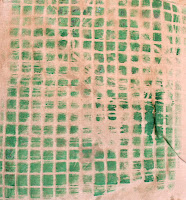I pressed the grid quite firmly into the surface when applying the fabric (of course you could use paper) so that I would get a replication of the pattern.
By looking closely at the photo, you can see how the gelatin surface has cracked, but this only adds texture to my print.

Gentle firm pressure is needed to imbed the hardware cloth into the gelatin so that you can obtain a successful print. Hardware cloth comes in two sizes at my local hardware store and I tried both, liking them equally well since I did not have a project in mind with predetermined specifications as to size.
Plastic needlepoint canvas might work as well and not be as hard on your surface, but I wanted to push the limits and see what it would take. It really didn't seem to have too much effect on the gelatin itself, but again, it was a heavily used plate, not a fresh one and I would not try this on a manufactured one.
A pattern was created and a ghost print can be made as well. This is where you apply a second piece of fabric or paper to get a lighter print after you pull the original one. This can result in even more interesting geometric patterns.
 |
| Completed print |
The moral of this story is to not be afraid to try anything in your work, to experiment with different textures and materials, items from your kitchen or garage, anything goes. Inexpensive craft acrylic paint that I had leftover from a several-years' old project, combined with a piece of hardware cloth from the garage and an 8" x 10" square of muslin made for a great starting point for a mixed media project. I'm off to create now with my new fabric!




Great effect. Will have to try this!
ReplyDelete